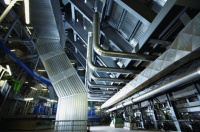
Engineers from Birmingham and Manchester universities, and industrial partners from Alstom Power, Corus, E.ON and TWI, are working on ways to mitigate potential problems caused by this with non-destructive remote monitoring.
The collaborators hope to develop an electromagnetic sensing system that can detect microstructural changes in steel structures, such as
boiler plate and pipe, at power stations operating at high pressures and temperatures.
Principal investigator Claire Davis, a ferrous metallurgy engineer at Birmingham, said the power-generation industry is only currently capable of monitoring steel structures during planned outages and it is often difficult to attain information as detailed as a change in microstructure.
Consequently, plant operators must often estimate the design life of structures, often leading to them being replaced unnecessarily.
’We believe that if you had some form of online monitoring then you could utilise your plant more effectively, use the full life and not have to replace components early because you don’t know what remnant life they have,’ she said.
The academic and industrial collaboration, which has received £358,553 from the Engineering and Physical Sciences Research Council, proposes monitoring the steel with electromagnetic sensors that would use an excitation coil to send a range of frequencies into the object being monitored.
The spectral-response signal from the object would be collected by sensing coils and analysed to determine its electromagnetic properties, which are related to the microstructure of the material.
Davis said she and AnthonyPeyton, a professor of electromagnetic tomography engineering at Manchester, have conducted preliminary trials with ’non-optimised’ sensors.
The trials used heat treatments to modify steel microstructures, which caused small changes in electromagnetic properties.
’We’re now going to do the proof of concept by taking power-generation steels – some that will have been in service and some that will be subjected to artificial ageing to simulate the effects of 20 to 30 years on the microstructure,’ she said. ’We will look at optimising the design of the sensor for picking up very small signals and looking at the design of the sensor from an industrial perspective to determine how we can put it in service in a power-generation environment.’
Davis said such monitoring will become a critical issue in the UK when supercritical coal-fuelled power stations – which run more efficiently by using extremely hot steam – are brought on line.
’The next-generation power stations will require different steel chemistries because they’ll be operating at higher temperatures,’ she said. ’If we start to change operating conditions then we don’t know how the steel will react. However if we can monitor in situ, with some non-destructive monitoring, then it will help to give us confidence regarding the use of the plant.’
There is much anticipation in the UK for supercritical power stations, which are said to produce output efficiencies of 45 to 50 per cent compared to subcritical power stations with efficiencies of 30 to 35 per cent. It is also believed that supercritical power stations emit up to 25 per cent less carbon dioxide.
The project, ’High-temperature in-situ monitoring of power-station steels using electromagnetic sensors’ (POWEREMS) is expected to produce results by March 2013.










Water Sector Talent Exodus Could Cripple The Sector
Maybe if things are essential for the running of a country and we want to pay a fair price we should be running these utilities on a not for profit...